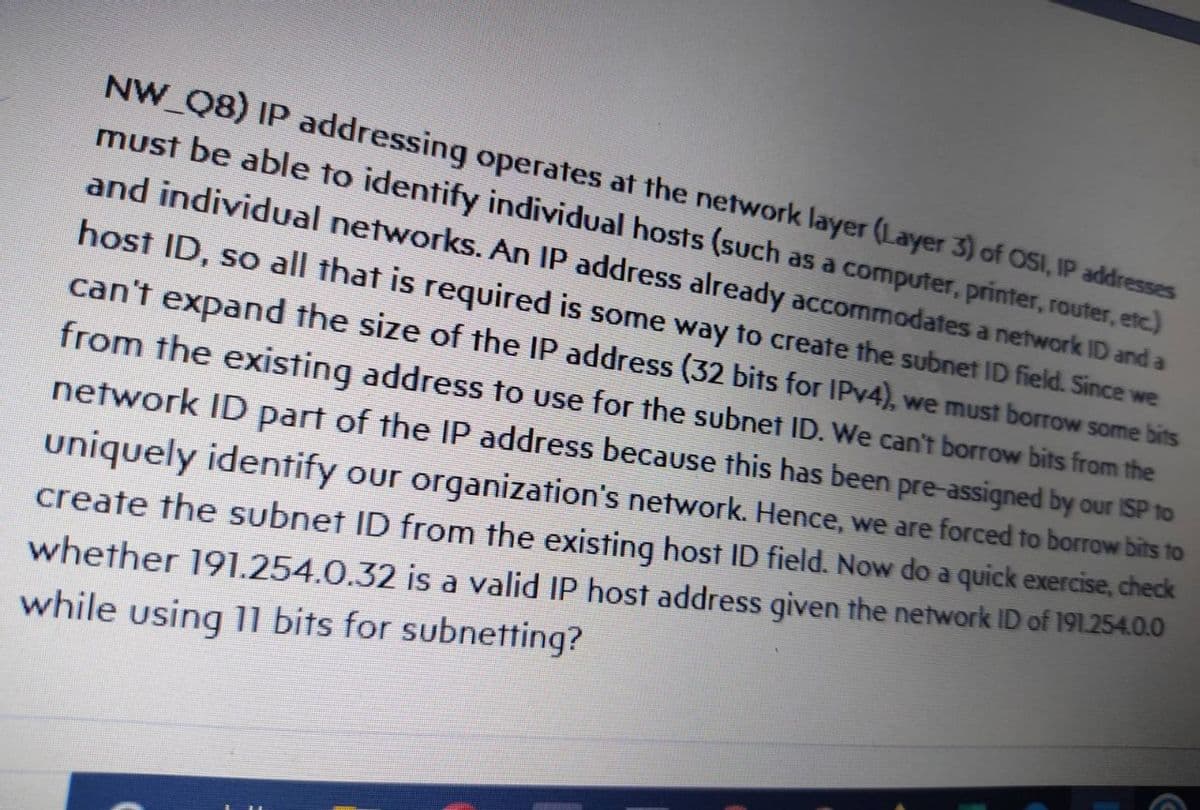agned by our ISP to s network. Hence, we are forced to borrow bits to create the subnet ID from the existing host ID field. Now do a quick exercise, check whether 191.254.0.32 is a valid IP host address given the network ID of 191.254.0.0 while using 11 bits for subnetting?
agned by our ISP to s network. Hence, we are forced to borrow bits to create the subnet ID from the existing host ID field. Now do a quick exercise, check whether 191.254.0.32 is a valid IP host address given the network ID of 191.254.0.0 while using 11 bits for subnetting?
Computer Networking: A Top-Down Approach (7th Edition)
7th Edition
ISBN:9780133594140
Author:James Kurose, Keith Ross
Publisher:James Kurose, Keith Ross
Chapter1: Computer Networks And The Internet
Section: Chapter Questions
Problem R1RQ: What is the difference between a host and an end system? List several different types of end...
Related questions
Question
100%
cn -assignmt

Transcribed Image Text:NW Q8) IP addressing operates at the network layer (Layer 3) of OSI, IP addresses
must be able to identify individual hosts (such as a computer, printer, router, etc.)
and individual networks. An IP address already accommodates a network ID and a
host ID, so all that is required is some way to create the subnet ID field. Since we
can't expand the size of the IP address (32 bits for IPV4), we must borrow some bits
from the existing address to use for the subnet ID. We can't borrow bits from the
network ID part of the IP address because this has been pre-assigned by our ISP to
uniquely identify our organization's network. Hence, we are forced to borrow bits to
create the subnet ID from the existing host ID field. Now do a quick exercise, check
whether 191.254.0.32 is a valid IP host address given the network ID of 191.254.0.0
while using 11 bits for subnetting?
Expert Solution
This question has been solved!
Explore an expertly crafted, step-by-step solution for a thorough understanding of key concepts.
Step by step
Solved in 3 steps

Recommended textbooks for you

Computer Networking: A Top-Down Approach (7th Edi…
Computer Engineering
ISBN:
9780133594140
Author:
James Kurose, Keith Ross
Publisher:
PEARSON

Computer Organization and Design MIPS Edition, Fi…
Computer Engineering
ISBN:
9780124077263
Author:
David A. Patterson, John L. Hennessy
Publisher:
Elsevier Science

Network+ Guide to Networks (MindTap Course List)
Computer Engineering
ISBN:
9781337569330
Author:
Jill West, Tamara Dean, Jean Andrews
Publisher:
Cengage Learning

Computer Networking: A Top-Down Approach (7th Edi…
Computer Engineering
ISBN:
9780133594140
Author:
James Kurose, Keith Ross
Publisher:
PEARSON

Computer Organization and Design MIPS Edition, Fi…
Computer Engineering
ISBN:
9780124077263
Author:
David A. Patterson, John L. Hennessy
Publisher:
Elsevier Science

Network+ Guide to Networks (MindTap Course List)
Computer Engineering
ISBN:
9781337569330
Author:
Jill West, Tamara Dean, Jean Andrews
Publisher:
Cengage Learning

Concepts of Database Management
Computer Engineering
ISBN:
9781337093422
Author:
Joy L. Starks, Philip J. Pratt, Mary Z. Last
Publisher:
Cengage Learning

Prelude to Programming
Computer Engineering
ISBN:
9780133750423
Author:
VENIT, Stewart
Publisher:
Pearson Education

Sc Business Data Communications and Networking, T…
Computer Engineering
ISBN:
9781119368830
Author:
FITZGERALD
Publisher:
WILEY